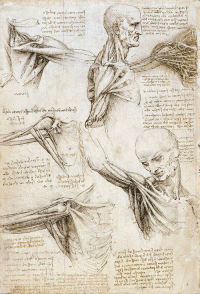The Body of Man Click on the thumbnails to explore the trail
Read more about this trail (expand)
According to Leonardo, man himself was at the centre of everything– “The measure of all things”. Throughout his life, the artist engaged in a dynamic and increasingly in-depth examination of man as a living organism, embarking on a seemingly unending quest to discover how man moved, grew, developed and perceived the world in which he lived.

- Enlarge
- The Royal Collection © 2005, Her Majesty Queen Elizabeth II
Anatomical studies of an old man Post 1510
By the second half of the 15th century, knowledge of human anatomy was an important element of artistic practice in Florence. Artists studied the life model in order to understand the structure of the body, its physical appearance and movements.
During the winter of 1507-08, Leonardo’s interest in human anatomy began to intensify. He embarked upon the dissection of a man who was more than one hundred years old. This marked the beginning of a period of intense study of human anatomy and physiology, which culminated in a group of anatomical drawings produced sometime after 1510. Leonardo probably executed them with a treatise on anatomy in mind.
On this sheet, Leonardo illustrates the head, neck and shoulder muscles of an aged man as seen from the side, front and back. By doing so, he adopts the technique of sculptors and architects to regard form in three-dimensions. The bodily forms are shown as they would appear without their outer coverings. The neat, ordered appearance of these sheets implies that they were not actual notes and sketches made during dissections, but collated drafts executed some time after.
In Leonardo's words
This plan of mine of the human body will be unfolded to you just as though you had the natural man before you. The reason is that if you wish to know thoroughly the parts of man after he has been dissected you must either turn to him, or your eye, so that you examine him from different aspects, from below, above, and from the sides…
On this sheet, Leonardo illustrates the head, neck and shoulder muscles of an aged man as seen from the side, front and back. By doing so, he adopts the technique of sculptors and architects to regard form in three-dimensions, whilst endeavouring to display the actual appearance of bodily forms as they would appear without their outer coverings.
The neat, finished technique of these drawings, together with the careful disposition of image and text implies that they were not actual notes and sketches made during dissections, but clean, collated drafts executed some time after.
- Medium Pen and ink over faint black chalk, on white paper
- Size 29.2 x 19.8 cm
- Location The Royal Collection










